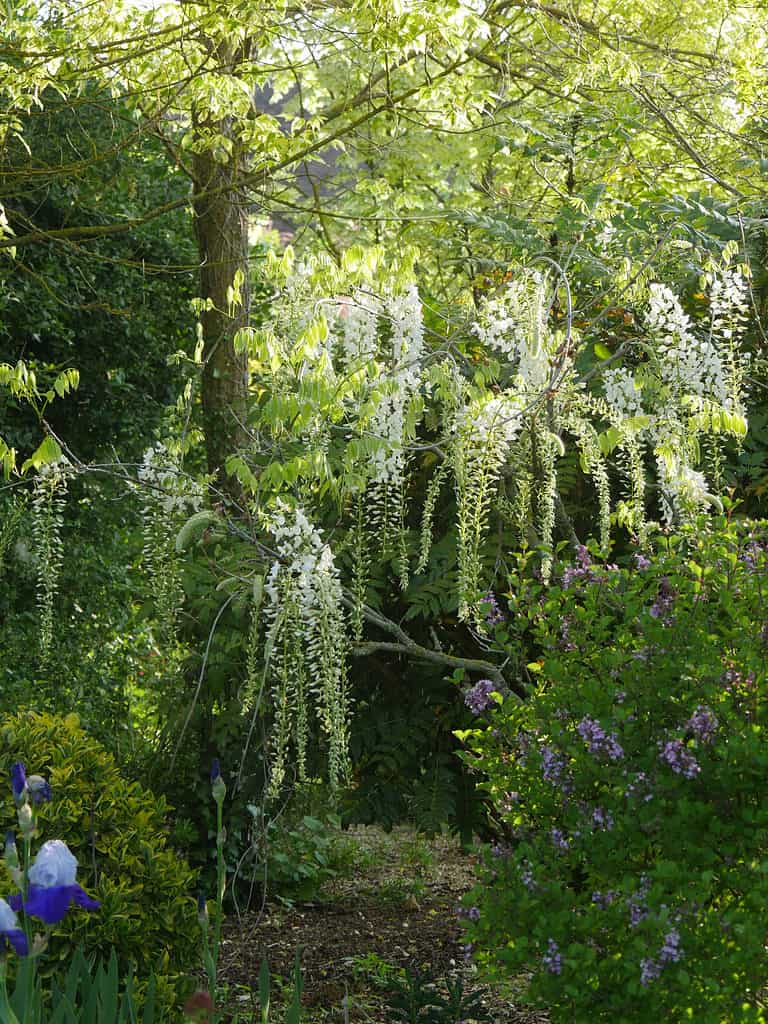Wisteria is a flowering vine or small tree with dangling clusters of fragrant flowers. Depending on the variety, wisteria is also an aggressive plant that tends to climb every structure in its path. But when wisterias are in bloom, their romantic cottage garden style and beauty are breathtaking.
When does wisteria bloom in the U.S.? Wisterias produce flowers in spring and summer in Zones 4–9, depending on which variety you plant.
Before we dig deeper into peak wisteria seasons by Zone, here are some essential facts every grower should know:
- It’s not uncommon for wisteria vines to be full of blooms one year and then produce few or no flowers the next. We offer some easy troubleshooting tips later in this article toward keeping wisteria blooming year after year.
- It takes 7-14 years for young wisteria vines to start blooming. Be patient, and prune them regularly while you wait.
- Wisteria can quickly become invasive if you don’t consistently manage its growth. Make sure the type of wisteria you grow isn’t listed as an invasive species in your state.
- Wisteria is toxic for humans and pets if ingested. In particular, the pods and seeds have high toxicity from chemicals called wisterin and lectin. According to Poison Control, ingesting any parts of the wisteria plant could result in vomiting, diarrhea, stomach cramps, and burning sensations in the mouth or throat.
Now, let’s take a deeper dive into when wisteria blooms by Zone. Then, we’ll discover which Hardiness Zones are ideal for each main type of wisteria plant.

Wisteria vines bloom in spring and summer. However, the plants usually perform best in Zones 4–9.
©alexgo.photography/Shutterstock.com
Zones Matter for Wisteria Survival and Blooms
By using the USDA Hardiness Zones map, wisteria growers can be more confident in the plant’s ability (or lack thereof) to survive in their local climate. How? By learning the average lowest temperatures in each Zone to compare with the plant’s growth habits.
For example, we learn from the USDA Hardiness Zones map that the lowest average temperatures in Zone 3 are -30 °F to -40 °F. However, many wisteria plants struggle to survive temps that low. So, gardeners in Zone 3 should consider growing Kentucky wisteria varieties (like Wisteria macrostachya ‘Blue Moon’) because they are hardy in Zones 3–9.
As for hotter Zones 9–11 and higher, we know from the average temperatures in these zones that:
- Wisterias might not achieve the kind of cold dormancy during the winter that they need to grow again next year. Consider growing small potted wisteria bonsai trees indoors in these Zones.
- Wisteria vines or trees are generally heat-tolerant but struggle to survive extreme heat conditions. For example, according to Arizona State University, Chinese wisteria (Wisteria sinensis) won’t survive temps above 110 °F. This limitation means that hot tropical climates aren’t ideal Zones for healthy wisteria vines.
Knowing the local Hardiness Zones also helps growers determine when their wisteria plants will bloom.
Wisteria Peak Season by Zone
See the table below for wisteria peak season by Zone. Also, note that if you live in colder climates than Zone 3, wisteria plants aren’t likely to thrive or bloom outdoors.
| USDA Hardiness Zones | Wisteria Peak Season | Ideal Wisteria for This Zone |
|---|---|---|
| Zones 2a-2b | Not recommended for Zone 2, as the winter temps are too cold | Consider planting a small Chinese or Japanese wisteria tree in a container indoors |
| Zones 3a-3b | late spring through early summer | Kentucky wisteria |
| Zones 4a-4b | mid to late spring through early summer | Kentucky wisteria Japanese wisteria |
| Zones 5a-5b | mid to late spring through early to mid summer | All Wisteria varieties |
| Zones 6a-6b | mid to late spring through early to mid summer | All Wisteria varieties |
| Zones 7a-7b | mid to late spring through early to mid summer | All Wisteria varieties |
| Zones 8a-8b | mid to late spring through early to mid summer | All Wisteria varieties |
| Zones 9a-9b | late spring through early summer | Kentucky wisteria Japanese wisteria Additional Wisteria varieties might struggle during Zone 9 high heat days |
| Zones 10a-10b | Not recommended for these Zones due to extreme heat days and no cold dormancy period | Consider planting a small Chinese or Japanese wisteria tree in a container indoors |
| Zones 11a-11b | Not recommended for these Zones due to extreme heat days and no cold dormancy period | Consider planting a small Chinese or Japanese wisteria tree in a container indoors |

Japanese wisteria blooms mid-spring through early summer in Zones 5-8.
©iStock.com/IsabelleMorand
Wisteria Plant Types and Bloom Timing
As with most plants, the peak season for wisteria can vary between plant varieties. For example, Kentucky wisteria will usually bloom later in the spring than Chinese wisteria.
See below for the five main types of wisteria plants and their bloom timing. However, always double-check the bloom timing for each cultivar you choose to grow. Some modern hybrids have different growth habits than other cultivars and heirloom plants.
American Wisteria (Wisteria frutescens)
- Blooms mainly in late spring and produces occasional flowers through summer in Zones 5–9
- Produces short and wide flower clusters and grows primarily in the eastern U.S.
Chinese Wisteria (Wisteria sinensis)
- Blooms from early spring to early summer in Zones 5-8
- It has shorter flower clusters than other varieties, but the flowers are long-lasting
- Chinese wisteria can be very invasive. For example, NC State Extension recommends growing alternative vines because Chinese wisteria is an invasive species in North Carolina.
Japanese Wisteria (Wisteria floribunda)
- Blooms mid-spring through early summer in Zones 4–9.
- A highly fragrant wisteria with long flower clusters that resemble flower chains (called racemes)
Kentucky Wisteria (Wisteria macrostachya)
- Blooms late spring through early summer in Zones 3–9.
- A very hardy plant that blooms later in the season than most other Wisteria varieties
Silky Wisteria (Wisteria brachybrotrys)
- Blooms late spring through early summer in Zones 5-8
- A type of Chinese wisteria with silky-haired foliage that produces more flowers as it matures
In addition, a similar flowering vine called evergreen wisteria (Millettia reticulata) thrives in warmer Zones 8-10. Evergreen wisteria blooms in summer and is less invasive than the plants listed above from the Wisteria genus. It’s also a lovely flowering perennial vine and a hardy wisteria alternative for tropical climates.

Wisteria blooms are romantic, but the plant’s toxicity isn’t. Be aware that wisteria seeds and pods are toxic for humans and pets if ingested.
©Marie A. Dolphin/Shutterstock.com
Why didn’t my wisteria bloom?
Wisteria is both vigorous and finicky. So, though its foliage might climb its way across every outdoor structure you own, this vine might not bloom every year.
If your wisteria isn’t blooming, ask yourself the following questions first. Resolving these issues might bring a lot more colorful flower clusters to your garden next year.
Is the wisteria getting enough sunlight?
Wisteria vines need 6-8 hours of direct sun daily. If they don’t get proper sunlight, they won’t produce many (if any) blooms.
Consider growing wisteria at the base of a west or south-facing wall or other sturdy tall structure. This location gives the vines plenty of sunlight and support.
Does the soil contain too much nitrogen?
You can usually spot a plant overloaded with nitrogen because they are foliage-heavy with no flowers. Wisterias are no exception.
If your wisteria isn’t blooming, test your soil’s pH level. The pH level indicates how acidic or alkaline the soil may be. Wisteria grows best in soil with a pH balance between 6.0 and 7.0.
The more acidic the soil, the lower the pH level. The more nitrogen in the ground, the more acidic it will be.
Here are two common ways to lower nitrogen for less acidic soil:
- Add mulch under your wisteria plants, which will help absorb excess nitrogen.
- Grow nitrogen-loving companion plants near wisteria, like squash and cabbage. These plants will absorb the excess nitrogen and thrive for doing so.
Is the wisteria vine too young to bloom?
It could take 7–14 years before wisteria vines are mature enough to bloom. So, you’re lucky if you buy property where the wisteria is already established. As long as it’s not taking over the whole yard, of course!
For those gardeners starting from scratch or dealing with newer plantings, be patient. Take great care of the wisteria vines so they will reward you with many blooms sooner rather than later.

Wisterias bloom more fully and more often if you prune them in summer and winter.
©romrodinka/ via Getty Images
How to Make Wisteria Vines Bloom Longer
If weather conditions are favorable, wisteria flowers can last up to two or three weeks on the vine! That’s plenty of time to enjoy the cottage garden elegance of these lavender, blue, or white cluster flowers.
But once the spent blooms close in spring, your wisteria plants might not fill with flowers again in quite the same way in summer.
To encourage impressive wisteria blooms more than once per growing season, follow these simple steps:
- Deadhead the spent wisteria blooms as often as possible. Removing dead flowers helps wisteria produce new ones more quickly.
- Prune wisteria’s long, trailing shoots in mid to late summer.
- Wisteria produces flowers from its new growth each year. So, pruning back its long shoots makes room for that new growth.
- Cutting back wisteria shoots (stems) helps the plant redirect its energy to flower production.
- To prune wisteria shoots, count to five buds away from the base of the stem and trim away the end portion that remains.
- Prune wisteria shoots again in winter when the plant is dormant. You can cut the shoots after the second or third bud from the base for winter pruning, which helps promote loads of spring flowers.
- Prune even young wisteria plants each year. Wisteria plants younger than seven years typically don’t bloom yet. However, pruning them back every year might encourage blooms from young plants sooner. So make wisteria pruning a consistent practice, no matter the age of the plant, for the most flowers possible.
Wisteria blooms add a romantic cottage garden style.
The thought of wisteria vines makes us think of charming English cottages dripping with delicate blooms. You may be able to have the same romantic blooms dangling from your home, pergola, or trellis in spring and summer, too.
Start by knowing your growing Zone’s average lowest temps, then select wisteria plants that thrive in your climate. Then, maintain wisteria growth with regular deadheading and pruning that encourages the vines to bloom again year after year.
Remember, before growing any wisteria, do a search for the specific plant through the USDA National Invasive Species Information Center. Always make sure it’s not listed as an invasive species in your area first.
The photo featured at the top of this post is © romrodinka/ via Getty Images
Thank you for reading! Have some feedback for us? Contact the AZ Animals editorial team.







